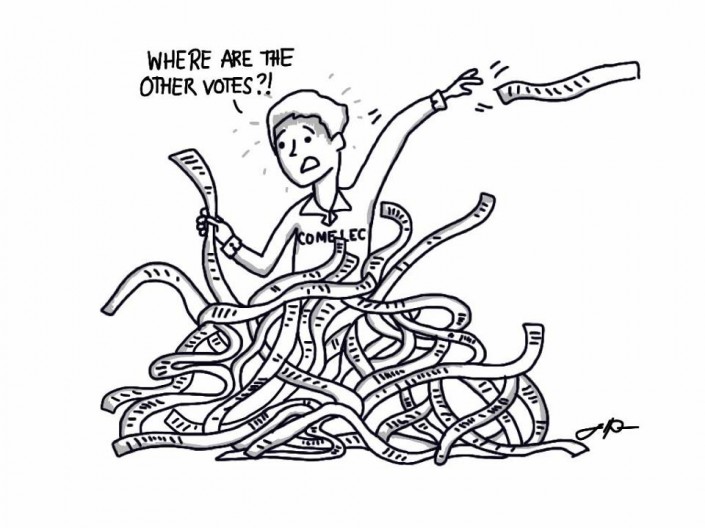Almost 10 years ago, economist Winnie Monsod told the media that the automation of vote counting and canvassing makes the typical cadena or electoral fraud syndicates “impossible to operate” while “relegating wholesale cheating – the dagdag-bawas operations of the municipal and provincial canvassing level – to the dustbin of history.”
Prior to the automation of elections in the country, sentiments such as Monsod’s were common and reflected a spirit of hope, a general perception of progress in the institutionalization of automated ballot counting. Then National Citizens’ Movement for Free Elections (NAMFREL) chairman Jose Concepcion went so far as to declare, “It is nearly impossible to cheat using computerized vote-counting machines. In a manual environment, cheating can be easily committed, but not in an automated environment.”
The situation during election day, however, suggests that where the integration of precinct count optical scan (PCOS) machines have brought the efficiency of the voting process ways away from the glacial pace of vote counting and canvassing in previous elections, it is not the be-all and end-all of ensuring a fair, free election.
Election watchdog Kontra Daya reports that technical difficulties with the PCOS machines made up 60 percent of poll problems reported. These problems engendered even more problems while opening avenues for others. The Commission on Elections (Comelec) reports that 200 to 300 PCOS machines were defective; the Parish Pastoral Council for Responsible Voting (PPCRV) reports 400. Beyond these claims, the overall experience not only with the genuinely defective machines but also those that merely malfunctioned suggest that the problem with the PCOS machines is not just in their inability to function but in their overall functionality, and ease of use for voters.
In many polling centers, the simple fact of delay in the delivery of PCOS machines or in the vote counting process itself caused disenfranchised voters in the problematic precincts to instead head home and forfeit their votes.Lasallians who volunteered with NAMFREL to monitor four polling centers yesterday reported by independent count as many as 13 malfunctioning machines in the four schools alone, approximately delaying the process for at least 50 precincts.
In addition, precincts with defective and malfunctioning machines, for lack of a better alternative, proceeded with the old method of simply collecting ballot boxes to be delivered either to the local canvassing committees, or locations ordered by less well-intentioned individuals and groups. Case in point, according to the updates of Lasallian NAMFREL poll watchers, a ballot box with votes from seven precincts in a Manila elementary school was ordered to be sent outside Metro Manila for canvassing, separately from other ballot boxes, under the orders of the school’s principal.
Consistently, the poll watchers monitored many other electoral violations in the assigned precincts: sample ballots with shaded candidates, political paraphernalia and blatant vote buying from “poll watchers”, the use of minors in electioneering within precincts and partisan assistants who “guided” voters without official permits, among others.
Despite statements from the PNP that the elections are ‘peaceful’, outside Metro Manila, electoral violence remains the norm, both during the campaign period and election day, which became particularly bloody in Sulu, Maguindanao and parts of Luzon. PNP figures cite 46 deaths during the entire period, and 72 reported incidents of electoral violence, 104 less than in 2010.
All these in mind, enforcement of Comelec policy remained the biggest problem, not quite differently from the pre-automation period. Where the Philippines is finally on track in working out its automated elections system, and PCOS machines have greatly expedited the counting and canvassing process, election monitoring groups and the Comelec still have a lot of work to do in terms of addressing the bigger problems that hinder the conduct of truly democratic voting.
With the next presidential elections only three years away, Comelec has to keep in mind that despite hopeful forecasts of automation 10 years ago, the cadenas have adapted and are still operating, and that the PCOS machines have not yet truly eradicated wholesale electoral fraud. Evaluating policies based on this year’s reports is a response, but is only one aspect of removing the impediments to a democratic election, just like automation is merely an important aspect of enabling that democratic environment. Electoral reform does not end with evaluation or automation: it ends, ultimately, in enforcement and vigilant action.
Even though this action, being more vigilant and critical of the flaws in the electoral system, holds governing authorities accountable and challenges them to be more capable of responsive execution, it is still not enough to vindicate electoral fraud and other obstructions to the basic exercise of voters’ political right. At the end of the day, people are not aware of how extensive the operation has been done, and why anomalies occur in the first place, even if voters’ education does happen.
Action is not confined to policymakers and electoral watchdogs that are themselves susceptible to organizational weaknesses, such as the conduct of abundant voters’ education campaigns that might be lacking effectiveness, or operation that might be logistically unsound and cannot be supported by adequately planned contingencies or sufficient government capital. Citizens then have to express the wrongs, and the vigilant action that falls to every voter and capable citizen to voice out what went wrong and how, in their precincts and their communities, and speak the truth to power, either online, or by themselves becoming part of election monitoring groups and organizations, instead of letting both the formal institutions and the stronger informal groups impede their right to a fair and free election.

